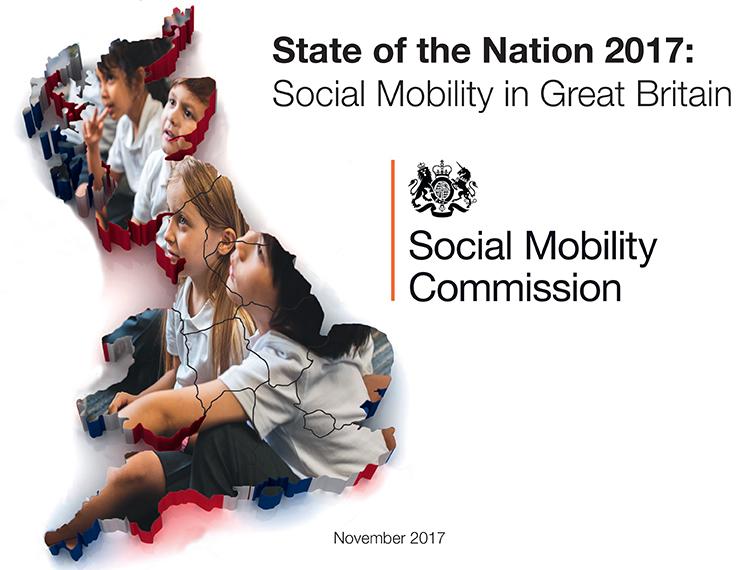Fifth State of the Nation Report: Social mobility in Great Britain – Sector Response

Social mobility in Great Britain: Report highlights the stark social mobility postcode lottery that exists in Britain
The fifth annual ‘State of the nation‘ report from the Social Mobility Commission was published today (28 Nov).
This report assesses the progress that Great Britain has made towards improving social mobility.
It puts the social mobility index at the heart of the report and ranks all English local authorities into hotspots and coldspots, using a range of 16 indicators for every life stage from the early years through to working lives.
It finds that there is a stark social mobility geographical divide within our nation.
A similar but not comparative approach is taken for Scotland and Wales.
A stark social mobility postcode lottery exists in Britain today where the chances of someone from a disadvantaged background succeeding in life is bound to where they live, the Social Mobility Commission’s ‘State of the nation’ report, published today (Tuesday 28 November) has found.
The report uncovers a striking geographical divide with London and its surrounding areas pulling away from the rest of the country, while many other parts of the country are being left behind economically and hollowed out socially.
It warns that Britain is in the grip of a self-reinforcing spiral of ever-growing division and calls on government to increase its proportion of spending on those parts of the country that most need it. Estimates suggest that the North is £6 billion a year underfunded compared to London.
At the heart of the report is the Social Mobility Index, which ranks all 324 local authorities in England in terms of their social mobility prospects for someone from a disadvantaged background. It uses a range of 16 indicators for every major life stage, from early years through to working lives, to map the nation’s social mobility hotspots and coldspots. A similar, but not comparable, approach has been taken for Scotland and Wales.
The report debunks the assumption that a simple north-south divide exists. Instead, it suggests there is a postcode lottery with hotspots and coldspots found in almost every part of the country. London dominates the hotspots, while the East and West Midlands are the worst performing regions. The best performing local authority area is Westminster and the worst performing area is West Somerset.
The index finds that the worst performing areas for social mobility are no longer inner city areas, but remote rural and coastal areas, and former industrial areas, especially in the Midlands. Young people from disadvantaged backgrounds living in these areas face far higher barriers than young people growing up in cities and their surrounding areas – and in their working lives, face lower rates of pay; fewer top jobs; and travelling to work times of nearly four times more than that of urban residents.
There is also no direct correlation between the affluence of an area and its ability to sustain high levels of social mobility. While richer areas tend to outperform deprived areas in the index, a number of places buck the trend. Some of the most deprived areas in England are hotspots, including most London boroughs – such as Tower Hamlets, Hackney and Newham. Conversely, some affluent areas – such as West Berkshire, Cotswold and Crawley – are amongst the worst for offering good education, employment opportunities and affordable housing to their more disadvantaged residents.
The report highlights that local policies adopted by local authorities and employers can influence outcomes for disadvantaged residents. But it also warns that there is a mind-blowing inconsistency of practice in how to improve social mobility outcomes, with little pooling of experience or evidence-based strategies.
 The Rt Hon Alan Milburn, chair of the Social Mobility Commission, said:
The Rt Hon Alan Milburn, chair of the Social Mobility Commission, said:
The country seems to be in the grip of a self-reinforcing spiral of ever-growing division. That takes a spatial form, not just a social one. There is a stark social mobility lottery in Britain today.
London and its hinterland are increasingly looking like a different country from the rest of Britain. It is moving ahead as are many of our country’s great cities. But too many rural and coastal areas and the towns of Britain’s old industrial heartlands are being left behind economically and hollowed out socially.
Tinkering around the edges will not do the trick. The analysis in this report substantiates the sense of political alienation and social resentment that so many parts of Britain feel. A new level of effort is needed to tackle the phenomenon of left behind Britain. Overcoming the divisions that exist in Britain requires far more ambition and far bigger scale. A less divided Britain will require a more redistributive approach to spreading education, employment and housing prospects across our country.
Key findings include:
- London accounts for nearly two-thirds of all social mobility hotspots
- The Midlands is the worst region of the country for social mobility for those from disadvantaged backgrounds – half of the local authority areas in the East Midlands and more than a third in the West Midlands are social mobility coldspots
- Some of the worst performing areas such as Weymouth and Portland, and Allerdale, are rural, not urban
- Coastal and older industrial towns – places such as Scarborough, Hastings, Derby and Nottingham – are becoming entrenched social mobility coldspots
- Some of the richest places in England, such as West Berkshire, Cotswold and Crawley, deliver worse outcomes for their disadvantaged children than places that are much poorer such as Sunderland and Tower Hamlets
- Apart from London, English cities are punching below their weight on social mobility outcomes. No other city makes it into the top 20%
- Early years – disadvantaged children are 14 percentage points less likely to be school ready at age 5 in coldspots than in hotspots: in 94 areas, under half of disadvantaged children reach a good level of development at age 5
- Schools – 51% of London children on free school meals achieve A* to C in English and maths GCSE compared to an average of 36% of children on free school meals in all other English regions: in the best place (Westminster), 63% get good English and maths GCSEs whereas in the worst (Isle of Wight), only 27% do
- A critical factor in the performance of top local authorities is the number and quality of teachers available. A secondary teacher in the most deprived area is 70% more likely to leave
- Schools in rural and coastal areas are isolated and lack partnerships with other schools. In Lancashire and West Yorkshire only 19% of all schools are either in a multi-academy trust or an equivalent trust compared to 35% in north east London and the East of England
- Youth – In Kensington and Chelsea, 50% of disadvantaged young people make it to university, whereas in Hastings, Barnsley and Eastbourne, the university participation rate for this group falls to just 10%
- One quarter of young people are NEET (not in education, employment or training) in the worst local authority area a year after GCSEs (South Ribble), compared to 1% in North Hertfordshire
- Working lives – In 71, largely rural areas, more than 30% of people earn below the voluntary living wage: average wages in the worst performing area, West Somerset, are £312 a week, less than half of the best performing areas of London such as Wandsworth, Richmond upon Thames and Westminster
- In Bolsover, just 17% of residents are in jobs that are professional and managerial positions, compared to 51% in Oxford
- City residents face barriers in their working lives with high housing costs and high rates of low paid work compared to commuter belt residents who benefit from higher rates of the top jobs and with more families owning their homes
- In Blaby, Rochford and Harborough, 80% of residents own their homes whereas in Tower Hamlets it is just 18%
Key recommendations:
- Every local authority should develop an integrated strategy for improving disadvantaged children’s outcomes and Pupil Premium funds should be invested in evidence-based practice
- Local authorities should support collaboration between isolated schools, subsidise transport for disadvantaged young people in isolated areas and encourage Local Enterprise Partnerships (LEP) to follow the North East LEP’s approach to improving careers support for young people
- Local authorities should all become accredited Living Wage employers and encourage others in their communities to do likewise
- Central government should launch a fund to enable schools in rural and coastal areas to partner with other schools to boost attainment
- Regional School Commissioners should be given responsibility to work with universities, schools and Teach First to ensure that there is a good supply of teachers in all parts of their regions
- The Department for Business, Energy and Industrial Strategy should match the Department for Education’s £72 million for the opportunity areas to ensure there is a collaborative effort across local education systems and labour markets
- Central government should rebalance the national transport budget to deliver a more equal share of investment per person and contribute towards a more regionally balanced economy
Commenting on the report by the Social Mobility Commission
Cllr Stephen Lambert, Director, Education4Democracy CIC, said:
Clearly the notion of a North-South divide is an over-simplification. What this report shows is that we have an ‘’intra-regional divide’’ in the North of England and a divide between growing core cities like Manchester, Newcastle and Leeds and small town Britain. Educational inequalities are as marked in coastal Hastings as they are inner-city Hackney, London whereas Harrogate in the North flourishes in all respects. The challenge is to tackle what are clearly class- based iniquities in educational performance, opportunity and occupational life-chances.
Kevin Courtney, joint general secretary, of the National Education Union said:
The latest Social Mobility Commission’s ‘State of the Nation’ report reveals the Government’s abject failure in tackling the root causes of poverty and inequality and in offering hope to communities across the country. The gap between the better off and the least well off is growing and Britain is an increasingly unequal and unfair society. The widening gap is the product of a failed approach to economic development and the incredibly short-sighted programme of austerity which has cut vital public services, including education budgets across the country.
Teachers do everything they can to help every child but they, and the children, are let down by the Governments failure to tackle inequality and childhood poverty. That we have four million children living in poverty is an absolute disgrace in the world’s fourth richest economy. If the Government was serious about improving children’s life chances it would have invested in early years rather than cutting Sure Start and funding for childcare; it would have increased school funding and local authority budgets for school support services not slashed them and it would have addressed the growing teacher recruitment and retention crisis. It would also have taken serious steps to develop a strategy for creating good quality jobs for young people through investment.
The crisis in teacher supply has fundamental causes that will not be addressed by giving more responsibility to Regional Schools Commissioners, as the report suggests. The root causes of the crisis in retention and recruitment are clear: uncompetitive pay and unsustainable workload and accountability pressures.
Tackling social mobility is one of the Department for Education’s priorities and the Opportunity Area programme focuses on those cold spots highlighted by the Social Mobility Commission. DfE recently published the first six of 12 action plans for Opportunity Areas, which will drive social mobility in these communities, through funding a range of targeted activity and projects. This includes £22 million which will be shared among all 12 Opportunity Areas through a new Essential Life Skills programme to help disadvantaged young people develop.
It is important to note that the Opportunity Area programmes include a wide variety of areas – including rural and coastal communities – which means that we can look at ways to help the very areas the report notes are falling behind.
 Education Secretary Justine Greening said:
Education Secretary Justine Greening said:
“The findings of the Social Mobility Commission underline the importance of focusing our efforts in more disadvantaged areas where we can make the biggest difference. By working to boost attainment and opportunity – both inside and outside the classroom – we want to help all young people in those areas fulfil their potential.
“Our Opportunity Areas programme is developing evidence-based approaches to tackle entrenched underperformance alongside wider investment to improve early numeracy, literacy, and teacher recruitment in areas that need it most, as well as working with businesses locally to raise sights and broaden horizons for young people.
“We are making progress – there are now 1.8 million more children in good or outstanding schools than in 2010. Disadvantaged young people are entering universities at record rates, and the attainment gap between them and their peers has narrowed. We are also boosting salaries through the introduction of the National Living Wage, creating more full-time, permanent jobs and investing £9 billion in affordable housing. Taken together, this won’t just change individual lives, it will help transform our country into a fairer society.”
About The Social Mobility Commission: An advisory, non-departmental public body established under the Life Chances Act 2010 as modified by the Welfare Reform and Work Act 2016. It has a duty to assess progress in improving social mobility in the United Kingdom and to promote social mobility in England. It currently consists of four commissioners and is supported by a small secretariat. The functions of the commission include: monitoring progress on improving social mobility, providing published advice to ministers on matters relating to social mobility, undertaking social mobility advocacy.
The commission board currently comprises:
- Alan Milburn (chair)
- Baroness Gillian Shephard (deputy chair)
- Paul Gregg, Professor of Economic and Social Policy, University of Bath
- David Johnston, Chief Executive of the Social Mobility Foundation










Responses